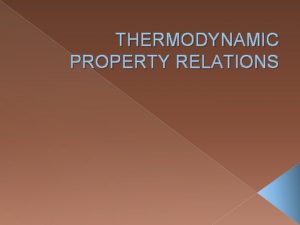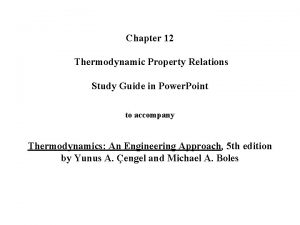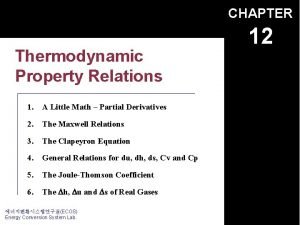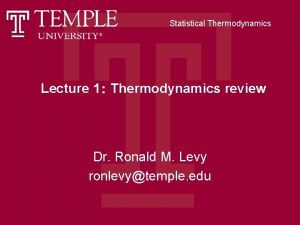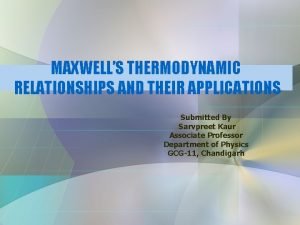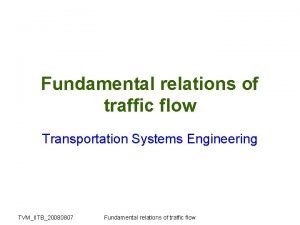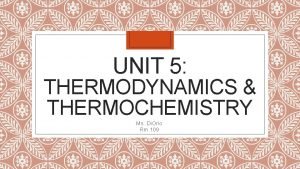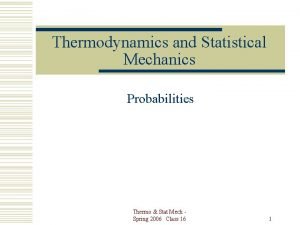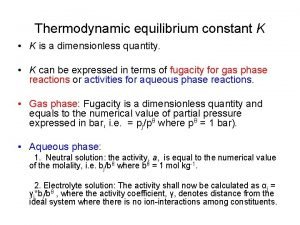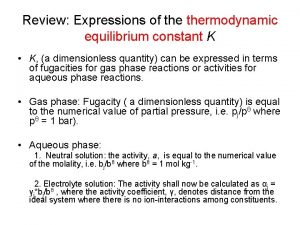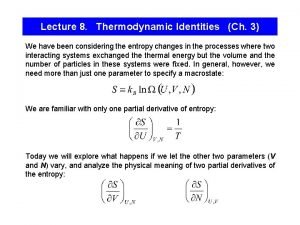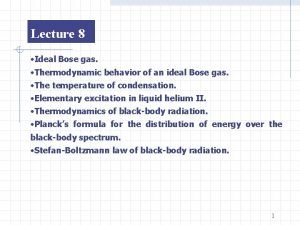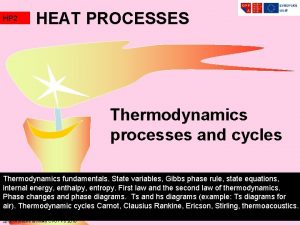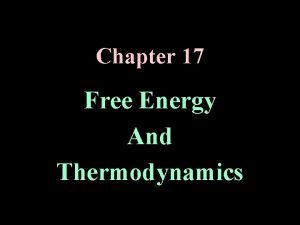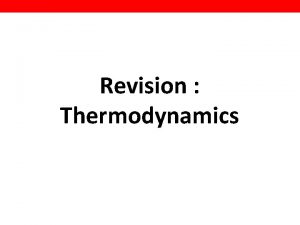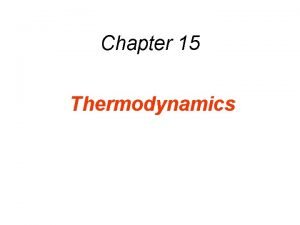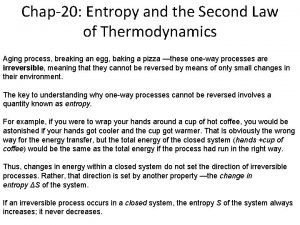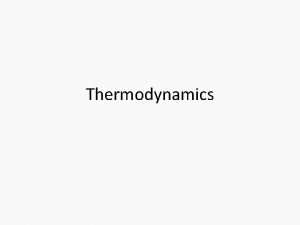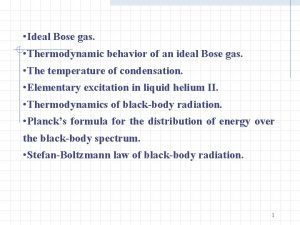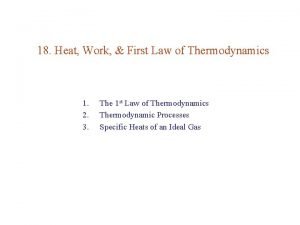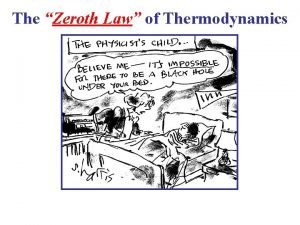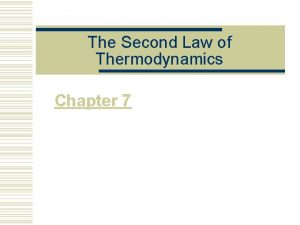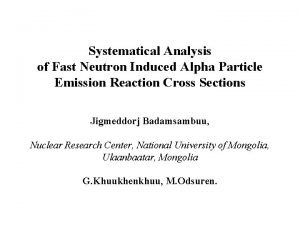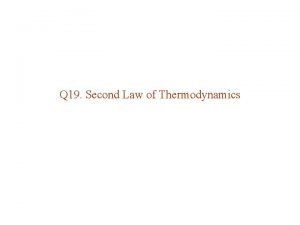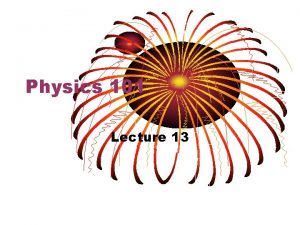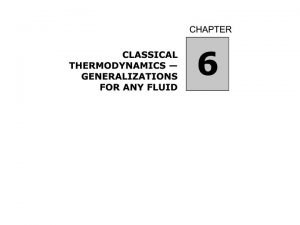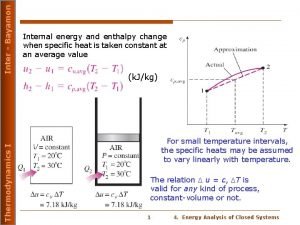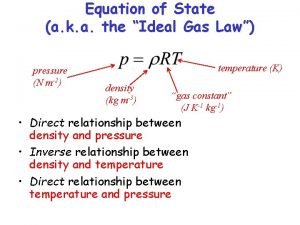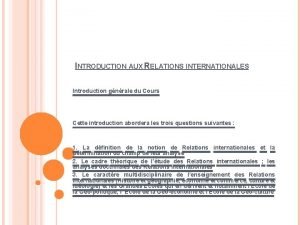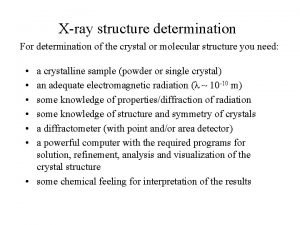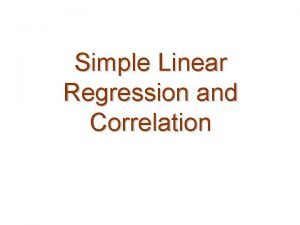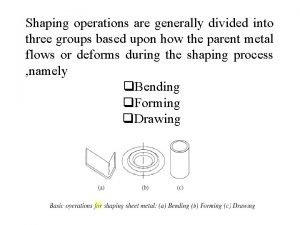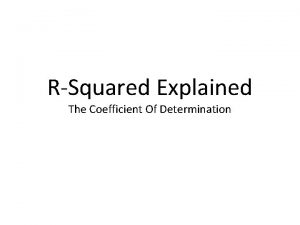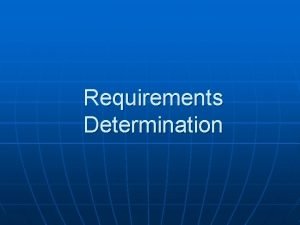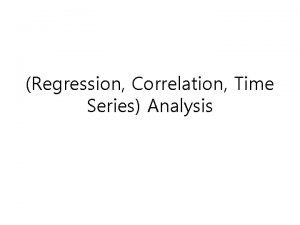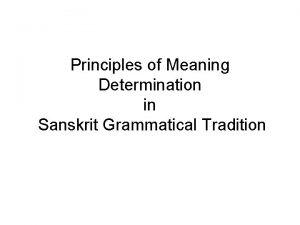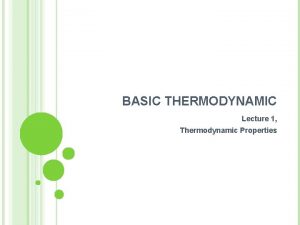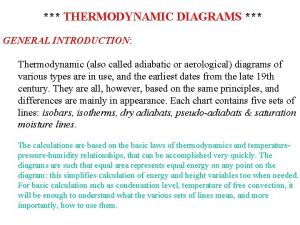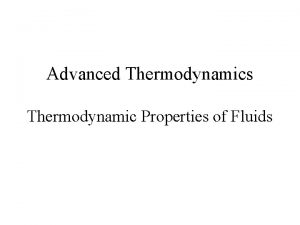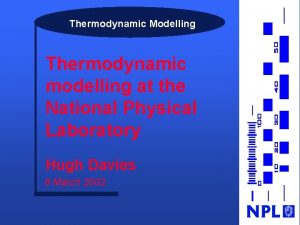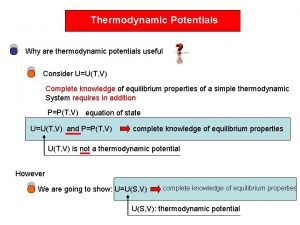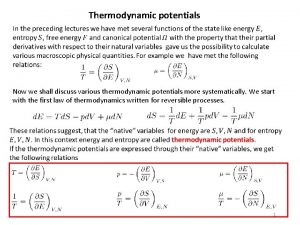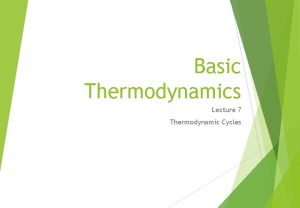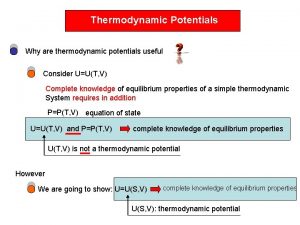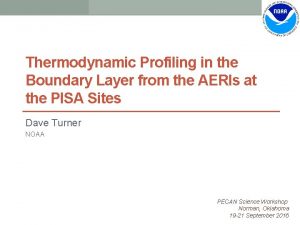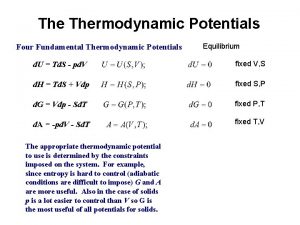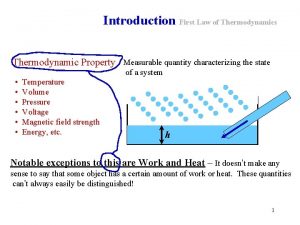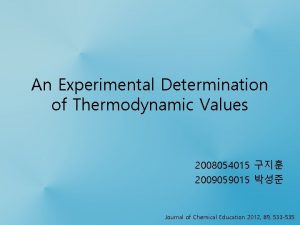THERMODYNAMIC PROPERTY RELATIONS 6 1 INTRODUCTION Determination of
























































- Slides: 56

THERMODYNAMIC PROPERTY RELATIONS 6. 1 INTRODUCTION Determination of properties is very fundamental to thermodynamic analysis. While some can be directly measured such as P, v, T, others such as u, h, s, are determined from measurable properties. For this the latter properties have to be expressed mathematically in terms of the former. This will require formulation of thermodynamic relations between properties. Also approximation techniques 1

will be developed as an alternative where sufficient data are not available to calculate properties. 6. 2 FUNDAMENTALS OF PARTIAL DERIVATIVES Properties are point functions expressed as functions of two independent variables. This qualifies them to be exact differentials. The functional relationship may be expressed as x=x(y, z) or f(x, y, z) = 0 And the total differential is expressed as 2

fig-chp 6fig 6. 1. pptx shows the basis of partial derivative formulation. Rewriting as dx=Mdy + Ndz Exact differentials satisfy They also satisfy the cyclic relation 6. 3 SOME FUNDAMENTAL RELATIONS 1 st law: δq=du+δw For a reversible process Tds=du+Pdv 1 st Tds equation. More useful form: du=Tds-Pdv u=u(s, v) Using the definition of enthalpy h=u+Pv 3

Differentiation gives dh=du+Pdv+vdp or du +Pdv=dh-vd. P Substitution in the 1 st Tds equation gives the 2 nd Tds equation : Tds=dh-vd. P also dh=Tds+vd. P h=h(s, P) Helmholtz function: a=u-Ts Differentiation gives da=du-Tds-sd. T Using 1 st Tds equation gives da=-Pdv-sd. T a=a(T, v) Gibbs function: g=h-Ts Differentiation gives dg=dh-Tds-sd. T Using the 2 nd Tds equation gives dg=vd. P-sd. T g=g(T, P) 4

Applying the test of exactness gives the famous Maxwell relations Also 6. 4 GENERALIZED RELATIONS FOR CHANGES IN S, U, AND H General equations indifferent to the type and phase of 5

of the substance are derived. Usually the two pairs of independent variables used are (T, v) and (T, P). Beginning with entropy as s=s(T, v) & 1 st Tds equation Also starting with s=s(T, P) & 2 nd Tds equation The following derived from Tds equations have been used. 6

With u=u(T, v) Using the 1 st Tds equation and Maxwell relation , after integration Substitution gives Similarly beginning with h=h(T, P) 7

Using the 2 nd Tds equation and Maxwell relation Substitution gives The determination of changes in s, u and h requires the knowledge of Pv. T behavior and experimental information on the relationship between specific heats and temperature. 8

6. 5 GENERALIZED RELATIONS FOR c. P AND cv Two general relations derived were Rewriting the ds equations The test of exactness will give 9

And The above two equations give the variation of specific heats with volume and pressure at a given temperature. As an example, integration of the second equation from zero pressure gives 10

where c. P, 0 is the zero pressure, or ideal gas, specific heat at the given temperature. The integration requires the knowledge of Pv. T behavior. If we equate the two ds expression (c. P-cv)is determined as follows: Division by d. P and imposing v=c yields 11

Using the cyclic relation for (∂P/∂ T)v will give 1. cp- cv must always be positive or zero. It becomes zero at T=0 and 2. It also becomes zero when (∂v/∂ T)P is ever zero. Eg. Maximum density of water at 4 o. C. 3. Since (∂v/∂ T)P is very small for liquids and solidsgives cp-cv ≈0 4. For an ideal gas cp-cv =R 12

Other properties dealing with expansivity and compressibility are Substitution of the above in the cp-cv expression gives The values of the coefficients are assumed to be constant in many calculations 13

Table 6. 1 β, KT, and ρ at 1 bar vs. temperature for (a) copper and (b) water

6. 6 RESIDUAL PROPERTY FUNCTIONS This is an alternate method to determine changes in properties such as u, h, and s in states other than the ideal-gas state. For any specific property y a residual function y. R is defined as y. R≡y*- y or y. R ≡ y - y* y is the desired value at T, P and y* is the property of an ideal gas at the same T, P (hypothetical). The change in property can be written as y 2 -y 1 = (y 2*-y 2 R)- (y 1*- y 1 R) = y 1 R - y 2 R + (y 2* - y 1*) With the above definitions Δh can be determined as 15

Referring to fig-chp 6fig 6. 2. pptx Using the definition of residual functions Similarly Δs can be determined as The first two are the residual terms. 16

Selecting state 1 as the reference state (ideal gas) at To and Po with ho* and so*, then the residual functions at one are zero. This will give Required are Pv. T data, ideal gas specific heat data and knowledge of the residual function. 17

6. 7 RESIDUAL PROPERTIES AND THE GIBBS FUNCTION Gibbs function given by dg=vd. P-sd. T is the convenient function to develop the residual function since it is expressed as g=g(P, T) and it will use those Pv. T relations that are explicit in v. Also dimensionless reduced function will be used as d(g. R/RT) where For an ideal gas 18

Subtraction of the first from the second gives the fundamental residual property relation as Integrating at constant T from P=0 (ideal gas) to system pressure gives The same equation at constant P gives h. R as 19

Also using g. R=h. R-Ts. R Using the compressibility factor Z, v/RT=Z/P and substitution gives 20

This will give Similarly it can easily be shown For a two parameter equation in terms of reduced properties 21

Similarly The above require Z=Z(Pr, Tr)-charts A-39 and A-40 For internal energy one can start from (u=h-Pv) 22

Using the three parameter equation with ω in the form of Z = Z(0) +ωZ(1) Since Substitution in the h. R/Ru. Tc expression gives 23

Similarly Tables A-26 through A-29 give the enthalpy and entropy residual functions. Example 6. 1 example. docx 24

6. 8 RESIDUAL PROPERTIES AND THE HELMHOLTZ FUNCTION As most equations are of the form P=P(v, T), the Helmholtz function, a=a(v, T) also looks to be convenient to derive residual property relations. da=-Pdv-sd. T or da=-Pdv at T=C Infinite v indicates an ideal gas situation, hence 25

To eliminate the difficulty of infinite limits on the lower and upper bound add and subtract the integral of RT/v as follows: Since Z was also defined as Z=vact/videal then Z=v/v* and this will give 26

ad To make it dimensionless divide by Ru. T To get the residual functions for s and h, start with da==Pdv-sd. T and noting that s=(∂a/∂T)v, hence Substitution of (a*-a) and taking the derivative with respect to T at constant v finally gives 27

For enthalpy residual function, start with h = u + Pv = a+Ts +Pv since a=u-Ts Then h. R = h*- h = (a*- a) + T(s*-s) + P*v*- Pv where P*v*=RT Substitutions for (a*-a) and (s*-s) will finally give 28

Using g=a+Pv and u=h-Pv the residual functions for g and u can be determined from g. R/Ru. T=a. R/Ru. T + 1 -Z and u. R/Ru. T=h. R/Ru. T + Z-1 All the above equations require P=P(v, T) 6. 9 FLOW AVAILABILITY FROM RESIDUAL FUNCTIONS ψR=(ψ*-ψ)T, P=[(h*-h)-(ho*-ho)]-To[(s*-s)-(so*-so)] In dimensionless form 29

This can be rearranged to give Change in exergy will be Example 6. 2 example. docx 6. 10 PROPERTIES OF THE SATURATION STATE Deals with liquid-vapor equilibrium of pure substances. Fundamental relationships among and approximate evaluation techniques for the basic properties P, T, u, h, s, a, and g are sought. 30

During phase change the heat supplied is called latent heat of evaporation, hfg and the change in entropy is given by hfg/Tsat. The combination gives hfg-Tsfg=0 or Δh-TΔs=0 (Phase change) From the definition of Gibbs function, g=h-Ts it follows Δg. T = Δh - TΔs = 0 for a phase change or gα =gβ or for the liquid-vapor phase gf=gg The equality of g for each phase is the criterion for phase quilibrium. From the relationship dg=vd. P-sd. T 31

We see that Since v and s change discontinuously, the derivatives also change discontinuously (fig-chp 6fig 6. 3. pptx ). c. P=T(∂s/∂T)P in the mixture region is infinite while it has finite values at single phase points. For changes of d. T and d. P on the two phase (figchp 6fig 6. 4. pptx ) equilibrium system at the initial state (i) gi. L=gi. V. At the final equilibrium position gi. L +dg. L=gi. V+dg. V Thus for the change d. T dg. L = dg. V 32

Using the expression for dg will give v. L d. P – s. L d. T = v. V d. P – s. V d. T And upon rearranging Since Δh = TΔs for a phase change 33

The above is called Clapeyron equation- Used to determine enthalpy of vaporization. Applicable to sublimation and melting too. At low pressures ideal gas behavior can be considered and also vf<<vg = RT/P. This will give All the above are known as Clausius-Clapeyron equations. For small temperature change hfg remains approximately constant. Integration gives 34

The above equation shows linearity between ln Psat and 1/T for a small change in T at low pressures. Actual observation is that the linearity holds from the triple state to the critical state. This can be seen by inserting Δv=(Zg – Zf)RT/P = ΔZ (RT/P) in the Clapeyron equation and gives the modified Clapeyron equation as The ratio hfg/Zfg tends to remain constant with a minimum value at Tr = 0. 85. Using Watson’s hfg=α(1 -Tr)0. 38 and Liley’s Zfg=β (1 -Tr)0. 38 35

Results in 6. 10. 1 Vapor-Pressure Correlations According to Clausius-Clapeyron equation vapor pressure can be fitted as Modification is made on the above equation by using the normal boiling point Tb (at 1 bar or 1 atm) and Tc and Pc to determine the constants A and B 36

This will give B=Atb giving A=Tc ln Pc/(Tc-Tb) and the final equation becomes (reasonably accurate over a fairly wide range of temperatures) To improve the accuracy over a wider range of temperatures, the change in hfg must be incorporated. A Typical empirical vapor pressure correlations in use is 37

If a two parameter corresponding state is used on the Clausius-Clapeyron equation (ln Psat = A-B/T) It can easily be converted to This gives a single straight line approximating the slope for all substances which is approximately true for simple fluids (ω<0. 05) as shown in figchp 6fig 6. 5. pptx. A second parameter is used to include the normal fluids in the form of Psat=f(Tsat, ω) Pitzer’s proposal 38

The values for the right hand expressions are given in A-30 Other proposals of the form ln Prsat=f(0) +ωf(1) due to Lee-Kessler ω=α/β (recommended) where α=-ln Pc-5. 92714+6. 09648Θ-1+1. 28862 ln Θ -0. 169347Θ 6 β=15. 2518 -15. 6875Θ-1 -13. 4721 ln Θ+0. 43577Θ 6 Θ=Tb/Tc , Pc (atm) 39

Satisfies definition of ω; curve passes through the critical state; curvature of the saturation line is zero at the critical state. Dong and Lienhard proposal: Its major advantage over the Lee-Kessler equation is that it predicts better over a wider range of ω. Satisfies the definition of ω, as well as the critical state condition. 40

6. 10. 2 Estimation of hfg Data Fishtine’s correlation using the normal boiling point Tb given by k=1 non-polar and 1<k<1. 38 for polar and hydrogen bonded compounds Reidel’s proposal 41

Watsons for non associating liquids requiring a knowledge of hfg at one temperature Application of three-parameter corresponding states uses Clapeyron equation d. P/d. T=Δs/Δv and since v=ZRT/P, then 42

Rewriting as Pr=f(Tr, ω) (slides 39 &40) and Table A-30 can be used for the above. Analytical correlation for ΔZ from Haggenmacher (1946) is also useful 43

A suitable three-parameter (vaporization) correlation has the form Δs = sfg = Δsv(0) + ωΔsv(1) Table A-30 gives the right hand expressions. Since hfg=Tsfg then (gives reasonable values for normal fluids) In dimensionless form 44

fig-chp 6fig 6. 6. pptx shows a linear function in the form of According to Reid for 0. 6 < Tr ≤ 1. 0 the curves are well represented by which is linear in ω for fixed Tr. 45

Finally a dimensionless correlation for temperature range Tc to triple state Tt according to Torquato and Stell and Torquato and Smith The equation represents the solid line of figchp 6fig 6. 7. pptx which fits the data for water. The above method requires hfg at the triple point (a major disadvantage). Example 6. 3 example. docx 46

6. 10. 3 Phase Equilibrium Properties from Equations of State For liquid vapor equilibrium g. L=g. V In terms of residual functions If P(v, T) is given, then 47

Using the expression for a. R yields As an example for RK fluid By first assuming Psat (using appropriate equations), RK equation (cubic in v) is solved for vf and vg and then Zg and Zf. Then check the equality of the phase equilibrium condition. If deviation is large, assume another Psat and repeat the procedure. 48

Then use to determine hg. R and hf. R. hfg= Ru. T(hg. R – hf. R) Finally sfg=hfg/T For building up the table for hf, hg , sf , sg in a saturation table requires a reference state. 49

6. 11 THE JOULE-THOMSON COEFFICIENT It has been seen that 1 st law applied on throttling devices resulted in an isenthalpic process h 1=h 2. Also called Joule-Thomson effect. This usually results in a cold temperature, where the end result can be a two phase fluid and separation occurs. Other properties such as specific volumes, specific heats, and enthalpies may be evaluated from measurements of the Joule-Thomson effect. 50

During throttling T may increase, decrease or stay the same while the enthalpy remains the same. Isenthalpic processes can be constructed as shown in fig-chp 6fig 6. 8. pptx. The Joule-Thomson coefficient is defined using this isenthalpic curve as The line formed by connection of the maximum points is called the inversion curve and the temperatures at these points are called inversion temperatures. 51

μJT is –ve to the right of the inversion line and +ve to the left of the inversion line. At high temperatures, many constant enthalpy lines may never pass through the inversion line: μJT is always negative. Such fluids must be artificially cooled before throttling (hydrogen and helium). Data for Joule-Thomson coefficient is frequently plotted against temperature for various pressures. Such a plot (or tabular data) shows the regions of pressure and temperature where a cooling effect is possible. fig-chp 6fig 6. 9. pptx is for argon and nitrogen while fig-chp 6fig 6. 10. pptx is for air. 52

Using the cyclic relation And substitution in μJT gives Recalling 53

The term in brackets is (∂h/∂P)T. This will give This permits evaluation of μJT if an equation of state explicit in v is at hand. The inversion curve can also be evaluated by setting μJT=0 and this will give the general criterion as -very sensitive test for an equation of state. 54

Using the equation of state Pv=ZRT and substitution of v=ZRT/P and (∂v/∂T)P= ZR/P+RT (∂Z/∂T)P/P will give Cooling occurs when the sign of (∂Z/∂T)P is positive. On the basis of the Z chart 1. For Pr<10, Z increases with increase in Tr until Tr reaches 5, beyond which the opposite occurs, ie. rise in T upon throttling. 2. For Pr>10, Z always decreases with increasing Tr 55

The above general analysis is in agreement with the generalized Pr – Tr diagram shown in figchp 6fig 6. 11. pptx , based on experimental data. Least squares fit of experimental data according to Miller With respect to relationships to othermodynamic properties, as an example to residual enthalpy 56
 Thermodynamic property relations
Thermodynamic property relations Volume expansivity and isothermal compressibility
Volume expansivity and isothermal compressibility Thermodynamic property relations
Thermodynamic property relations Maxwell's relations thermodynamics
Maxwell's relations thermodynamics Deriving maxwell relations
Deriving maxwell relations Thermodynamic relations
Thermodynamic relations Employee relations in public relations
Employee relations in public relations Associative vs commutative
Associative vs commutative Sapratibandha daya and apratibandha daya
Sapratibandha daya and apratibandha daya Chemical property definition
Chemical property definition Thermodynamic vs kinetic control
Thermodynamic vs kinetic control Mech
Mech Thermodynamic equilibrium constant k
Thermodynamic equilibrium constant k Van't hoff reaction isotherm
Van't hoff reaction isotherm Thermodynamic identity
Thermodynamic identity Thermodynamic behaviour of ideal bose gas
Thermodynamic behaviour of ideal bose gas Cp-cv=r/m
Cp-cv=r/m Gibbs free energy equation
Gibbs free energy equation Thermodynamic formula sheet
Thermodynamic formula sheet Thermodynamic
Thermodynamic Thermodynamic
Thermodynamic Thermodynamic second law
Thermodynamic second law Intensive properties in thermodynamics
Intensive properties in thermodynamics Thermodynamic behaviour of ideal bose gas
Thermodynamic behaviour of ideal bose gas Etransl
Etransl Thermodynamic
Thermodynamic Second law of thermodynamic
Second law of thermodynamic Thermodynamic temperature
Thermodynamic temperature Second law of thermodynamic
Second law of thermodynamic Change in entropy formula
Change in entropy formula Organic chemistry (3rd) edition chapter 1 problem 16s
Organic chemistry (3rd) edition chapter 1 problem 16s Thermodynamic control
Thermodynamic control Curtin-hammett principle
Curtin-hammett principle Gibbs free energy
Gibbs free energy Cp in thermodynamics
Cp in thermodynamics Thermodynamic
Thermodynamic Bergeron process definition
Bergeron process definition Introduction to industrial relations
Introduction to industrial relations Introduction aux relations internationales cours
Introduction aux relations internationales cours Income from house property introduction
Income from house property introduction Introduction to property valuation
Introduction to property valuation X-ray structure determination
X-ray structure determination Coefficient of determination interpretation
Coefficient of determination interpretation Blank determination example
Blank determination example Sex linkage
Sex linkage Sex determination brainpop quiz answers
Sex determination brainpop quiz answers Sex determination in drosophilla
Sex determination in drosophilla Self-determination worksheets pdf
Self-determination worksheets pdf Sample size determination
Sample size determination Shipping point determination
Shipping point determination Shipping point determination sap
Shipping point determination sap R squared interpretation
R squared interpretation Requirement determination
Requirement determination Durbin watson test interpretation
Durbin watson test interpretation Quality control standards
Quality control standards Metodo di lowry
Metodo di lowry Determination in sanskrit
Determination in sanskrit
